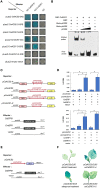A Positive Feedback Loop Mediated by CsERF31 Initiates Female Cucumber Flower Development: ETHYLENE RESPONSE FACTOR31 mediates a positive feedback loop that initiates female cucumber flower development
- PMID: 33744968
- PMCID: PMC8195516
- DOI: 10.1093/plphys/kiab141
A Positive Feedback Loop Mediated by CsERF31 Initiates Female Cucumber Flower Development: ETHYLENE RESPONSE FACTOR31 mediates a positive feedback loop that initiates female cucumber flower development
Abstract
Sex determination is a crucially important developmental event that is pervasive throughout nature and enhances the adaptation of species. Among plants, cucumber (Cucumis sativus L.) can generate both unisexual and bisexual flowers, and the sex type is mainly controlled by several 1-aminocyclopropane-1-carboxylic acid (ACC) synthases. However, the regulatory mechanism of these synthases remains elusive. Here, we used gene expression analysis, protein-DNA interaction assays and transgenic plants to study the function of a gynoecium-specific gene, ETHYLENE RESPONSE FACTOR31 (CsERF31), in female flower differentiation. We found that in a predetermined female flower, ethylene signalling activates CsERF31 by CsEIN3, and then CsERF31 stimulates CsACS2, which triggers a positive feedback loop to ensure female rather than bisexual flower development. A similar interplay is functionally conserved in melon (Cucumis melo L.). Knockdown of CsERF31 by RNAi causes defective bisexual flowers to replace female flowers. Ectopic expression of CsERF31 suppresses stamen development and promotes pistil development in male flowers, demonstrating that CsERF31 functions as a sex switch. Taken together, our data confirm that CsERF31 represents the molecular link between female-male determination and female-bisexual determination, and provide mechanistic insight into how ethylene promotes female flowers, rather than bisexual flowers, in cucumber sex determination.
Keywords: ERF; cucumber; ethylene signalling; positive-feedback; sex determination; unisexual flower.
© The Author(s) 2021. Published by Oxford University Press on behalf of American Society of Plant Biologists. All rights reserved. For permissions, please email: journals.permissions@oup.com.
Figures






Similar articles
-
A positive feedback loop mediated by CsERF31 initiates female cucumber flower development.Plant Physiol. 2021 Mar 21:kiab141. doi: 10.1093/plphys/kiab141. Online ahead of print. Plant Physiol. 2021. PMID: 33787923
-
Differential Gene Expression Caused by the F and M Loci Provides Insight Into Ethylene-Mediated Female Flower Differentiation in Cucumber.Front Plant Sci. 2018 Aug 14;9:1091. doi: 10.3389/fpls.2018.01091. eCollection 2018. Front Plant Sci. 2018. PMID: 30154805 Free PMC article.
-
An ACC Oxidase Gene Essential for Cucumber Carpel Development.Mol Plant. 2016 Sep 6;9(9):1315-1327. doi: 10.1016/j.molp.2016.06.018. Epub 2016 Jul 9. Mol Plant. 2016. PMID: 27403533
-
Revisit and explore the ethylene-independent mechanism of sex expression in cucumber (Cucumis sativus).Plant Reprod. 2024 Dec;37(4):409-420. doi: 10.1007/s00497-024-00501-1. Epub 2024 Apr 10. Plant Reprod. 2024. PMID: 38598160 Review.
-
[Sex determination in cucurbits].Biol Aujourdhui. 2012;206(1):57-62. doi: 10.1051/jbio/2012005. Epub 2012 Apr 3. Biol Aujourdhui. 2012. PMID: 22463996 Review. French.
Cited by
-
Citrus ACC synthase CiACS4 regulates plant height by inhibiting gibberellin biosynthesis.Plant Physiol. 2023 Jul 3;192(3):1947-1968. doi: 10.1093/plphys/kiad159. Plant Physiol. 2023. PMID: 36913259 Free PMC article.
-
The transcription factor CmERFI-2 represses CmMYB44 expression to increase sucrose levels in oriental melon fruit.Plant Physiol. 2023 May 31;192(2):1378-1395. doi: 10.1093/plphys/kiad155. Plant Physiol. 2023. PMID: 36938625 Free PMC article.
-
Exogenous auxin-induced ENHANCER OF SHOOT REGENERATION 2 (ESR2) enhances femaleness of cucumber via activating CsACS2 gene.Hortic Res. 2022 Jan 20;9:uhab085. doi: 10.1093/hr/uhab085. Online ahead of print. Hortic Res. 2022. PMID: 35048108 Free PMC article.
-
A cucumber NAM domain transcription factor promotes pistil development in Arabidopsis.Mol Hortic. 2021 Sep 15;1(1):10. doi: 10.1186/s43897-021-00013-w. Mol Hortic. 2021. PMID: 37789410 Free PMC article. No abstract available.
-
Multi-Omics Analysis Reveals Intricate Gene Networks Involved in Female Development in Melon.Int J Mol Sci. 2023 Nov 29;24(23):16905. doi: 10.3390/ijms242316905. Int J Mol Sci. 2023. PMID: 38069227 Free PMC article.
References
-
- Bai SL, Peng YB, Cui JX, Gu HT, Xu LY, Li YQ, Xu ZH, Bai SN (2004) Developmental analyses reveal early arrests of the spore-bearing parts of reproductive organs in unisexual flowers of cucumber (Cucumis sativus L). Planta 220: 230–240 - PubMed
-
- Bai SN, Xu ZH (2012) Bird–nest puzzle: can the study of unisexual flowers such as cucumber solve the problem of plant sex determination? Protoplasma 249: 119–123 - PubMed
-
- Boualem A, Fergany M, Fernandez R, Troadec C, Martin A, Morin H, Sari MA, Collin F, Flowers JM, Pitrat M, et al. (2008) A conserved mutation in an ethylene biosynthesis enzyme leads to andromonoecy in melons. Science 321: 836–838 - PubMed
LinkOut - more resources
Full Text Sources
Other Literature Sources

